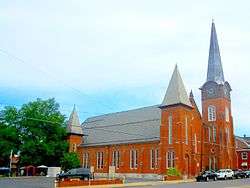Huntingdon, Pennsylvania
| Huntingdon, Pennsylvania Standing Stone Village (historical) | |
|---|---|
| Borough | |
|
Presbyterian Church | |
| Nickname(s): Ye Ancient Borough (historical) | |
| Motto: "Our Home, Our Town" | |
 Location of Huntingdon in Huntingdon County, Pennsylvania. | |
 Huntingdon, Pennsylvania Location of Huntingdon in Huntingdon County, Pennsylvania. | |
| Coordinates: 40°29′43″N 78°0′47″W / 40.49528°N 78.01306°WCoordinates: 40°29′43″N 78°0′47″W / 40.49528°N 78.01306°W | |
| Country | United States |
| State | Pennsylvania |
| County | Huntingdon |
| Plat drawn of streets and lots | 1767 |
| Incorporated | 1796 |
| Government | |
| • Type | Borough Council |
| • Mayor | Dee Dee Brown (R), elected 2009 |
| Area[1] | |
| • Total | 3.71 sq mi (9.61 km2) |
| • Land | 3.62 sq mi (9.37 km2) |
| • Water | 0.09 sq mi (0.24 km2) |
| Elevation | 643 ft (196 m) |
| Population (2010) | |
| • Total | 7,093 |
| • Estimate (2016)[2] | 6,990 |
| • Density | 1,932.54/sq mi (746.10/km2) |
| Time zone | Eastern (EST) (UTC-5) |
| • Summer (DST) | EDT (UTC-4) |
| Zip code | 16652, 16654 |
| Area code(s) | 814 |
| FIPS code | 42-36368 |
| Website | Huntingdon Borough |
Huntingdon is a borough in (and the county seat of) Huntingdon County, Pennsylvania, United States. It is located along the Juniata River, approximately 32 miles (51 km) east of Altoona and 98 miles (158 km) west of Harrisburg. It is the largest population center near Raystown Lake, a winding, 28 miles (45 km) long flood-control reservoir managed by the U. S. Army Corps of Engineers. The borough is located on the main line of the Norfolk Southern (formerly Pennsylvania) Railroad, in an agricultural and outdoor recreational region with extensive forests and scattered deposits of ganister rock, coal, fire clay, and limestone. Historically, the region surrounding Huntingdon was dotted with iron furnaces and forges, consuming limestone, iron ore and wood (for charcoal production) throughout the 19th century. Dairy farms dominate the local agriculture. The town is a regular stop for the Amtrak passenger service which connects Harrisburg with Pittsburgh.
Huntingdon is home to Juniata College, a private liberal arts college founded by members of the Church of the Brethren in 1876, and branch campuses of DuBois Business College and Penn Highlands Community College. In adjoining Smithfield Township (across the Juniata River) are the regional headquarters of the Pennsylvania Game Commission (Southcentral Division) and the Bureau of Forestry (Rothrock State Forest). State Game Lands 322 extends north from Huntingdon Borough in the direction of Petersburg. Public parks are the George N. Weaver Memorial Park (ball field and playground) at the end of 16th Street, Portstown Park along the Juniata River, and Blair Field bordering Standing Stone Creek. Historic Blair Park, directly across the same stream, is owned and managed by a nonprofit group; it contains a gazebo, and a level hiking and biking trail. A vintage chapel within the park is used by the congregation of Epiphany of Our Lord Orthodox Church.
In 2009, Huntingdon was named by Budget Travel magazine's readers as the 5th Coolest Small Town in the United States. Results were announced on The Early Show on April 15, 2009 by Budget Travel's editor in chief Nina Willdorf and show host Harry Smith.[3]
In 2015, Huntingdon was chosen by Niche.com as the 7th Best City to Retire in Pennsylvania.[4]
Huntingdon is the nearest town to the Allegrippis Trail system, currently ranked #15 on the list of "The BEST Mountain Bike Trails in the World."[5]
From June 8 to 11, 2017, Huntingdon celebrated it's 250th Anniversary. [6]
History
In 1768, Rev. Dr. William Smith began selling lots on the Standing Stone Tract along the Juniata, land he had recently acquired. The tract's two prior owners had not attempted to lay out a town, so Dr. Smith is considered the founder. Huntingdon (the name by which he eventually called his town) sits at the site of corn fields that had been cultivated at a date now unknown, next to where Standing Stone Creek flows into the Juniata River. The 100th anniversary of its incorporation was marked by the erection of a “Standing Stone Monument” on Third Street, modeled on a tall, narrow shaft known to have existed before 1750, whose purpose is unclear but may have served as a trail marker. It may be significant that natural sandstone formations (popularly called Pulpit Rocks), which "stand erect," are on a nearby ridge. A story surfaced during the early 19th century that Smith had renamed Standing Stone Settlement to honor an Englishwoman, Selina, the Countess of Huntingdon, England. Smith's descendants vehemently denied the story, and there exists no evidence to support it, despite a wide circulation in published sources. More likely, the Anglican cleric named it after the town of the same name in England; doing so had become a pattern for naming Pennsylvania settlements, Bedford, Carlisle and York being nearby examples of the trend. In 1796, the little village was incorporated as a borough.
Huntingdon long served as the junction of the Huntingdon and Broad Top Mountain Railroad with the Pennsylvania Railroad, and as an important port on the Main Line of Public Works of the Pennsylvania Canal. In past years, Huntingdon boasted of manufacturers of flour, heavy machinery, radiators, furniture, stationery, woolen goods, shirts, shoes, electronic components, finished lumber, fiberglass yarn, matting and underground storage tanks. In the 19th century, J. C. Blair, a native of Shade Gap and a stationer and businessman, popularized the writing tablet and began marketing it nationwide. His factory in downtown Huntingdon was later relocated to nearby Alexandria. The vicinity (but not much of the town proper) has been the subject of repeated flooding, in 1889, in 1936, and again in 1972. More recently in 2004, Hurricane Ivan resulted in major flooding close to Huntingdon, the worst since the remnants of Hurricane Agnes stalled over the region in July 1972.
The Huntingdon Borough Historic District was listed on the National Register of Historic Places in 1986.[7]
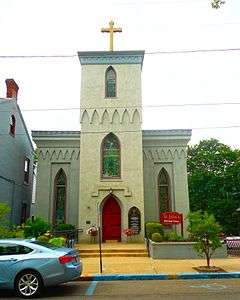 St. Johns Episcopal Church
St. Johns Episcopal Church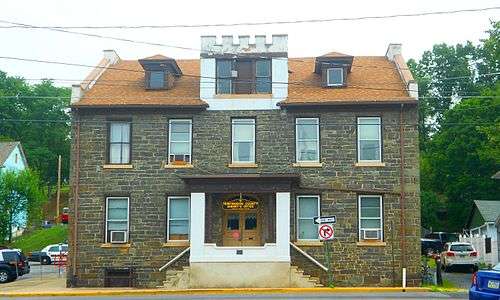 Huntingdon County Sheriff's Office
Huntingdon County Sheriff's Office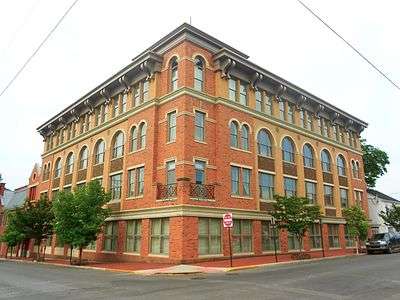 Building at 4th and Washington Streets
Building at 4th and Washington Streets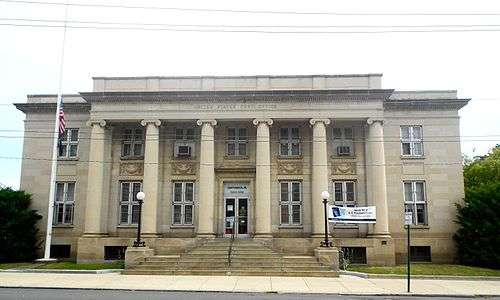 Post office
Post office
Geography
Huntingdon is located at 40°29′43″N 78°0′47″W / 40.49528°N 78.01306°W (40.495187, -78.013147).[8]
According to the United States Census Bureau, the borough has a total area of 3.5 square miles (9.1 km2), of which only 0.1 square miles (0.26 km2) (2.55%) is water.
Adjacent Municipalities
The following municipalities are also located in Huntingdon County, bordering on the Borough:
Climate
| Climate data for Huntingdon, Pennsylvania | |||||||||||||
|---|---|---|---|---|---|---|---|---|---|---|---|---|---|
| Month | Jan | Feb | Mar | Apr | May | Jun | Jul | Aug | Sep | Oct | Nov | Dec | Year |
| Record high °F (°C) | 79 (26) |
77 (25) |
85 (29) |
95 (35) |
98 (37) |
100 (38) |
105 (41) |
105 (41) |
102 (39) |
97 (36) |
79 (26) |
73 (23) |
105 (41) |
| Average high °F (°C) | 38 (3) |
39 (4) |
50 (10) |
62 (17) |
74 (23) |
82 (28) |
85 (29) |
83 (28) |
78 (26) |
66 (19) |
52 (11) |
40 (4) |
62.4 (16.8) |
| Average low °F (°C) | 19 (−7) |
19 (−7) |
27 (−3) |
36 (2) |
46 (8) |
55 (13) |
59 (15) |
58 (14) |
51 (11) |
39 (4) |
31 (−1) |
22 (−6) |
38.5 (3.6) |
| Record low °F (°C) | −29 (−34) |
−23 (−31) |
−10 (−23) |
6 (−14) |
21 (−6) |
29 (−2) |
42 (6) |
36 (2) |
24 (−4) |
13 (−11) |
−10 (−23) |
−22 (−30) |
−29 (−34) |
| Average precipitation inches (mm) | 2.8 (71) |
2.5 (64) |
3.5 (89) |
3.3 (84) |
3.8 (97) |
3.9 (99) |
3.9 (99) |
3.7 (94) |
3.0 (76) |
2.8 (71) |
2.6 (66) |
2.7 (69) |
38.5 (979) |
| Source: Weatherbase[9] | |||||||||||||
Demographics
As of the census[10] of 2010, there were 7,093 people, 2,674 households, and 1,461 families residing in the borough.
| Historical Population | ||
|---|---|---|
| Year | Pop. | ±% p.a. |
| 1800 | 688 | — |
| 1810 | 676 | −0.18% |
| 1820 | 848 | +2.29% |
| 1840 | 1,145 | +1.51% |
| 1850 | 1,470 | +2.53% |
| 1860 | 1,890 | +2.54% |
| 1870 | 3,634 | +6.76% |
| 1880 | 4,125 | +1.28% |
| 1890 | 5,729 | +3.34% |
| 1900 | 6,053 | +0.55% |
| 1910 | 6,861 | +1.26% |
| 1920 | 7,051 | +0.27% |
| 1930 | 7,558 | +0.70% |
| 1940 | 7,170 | −0.53% |
| 1950 | 7,330 | +0.22% |
| 1960 | 7,234 | −0.13% |
| 1970 | 6,987 | −0.35% |
| 1980 | 7,042 | +0.08% |
| 1990 | 6,843 | −0.29% |
| 2000 | 6,918 | +0.11% |
| 2010 | 7,093 | +0.25% |
| 2016 | 6,990 | −0.24% |
| Sources:[11][10][12] Source: | ||
The population density was 2,026.6 people per square mile (779.5/km²). There were 2,911 housing units at an average density of 831.7 per square mile (319.9/km²). The racial makeup of the borough was 94.61% White, 1.93% Black or African American, 0.07% Native American, 1.51% Asian, 0.31% from other races, and 1.56% from two or more races. Hispanic or Latino of any race were 1.49% of the population.
There were 2,674 households, out of which 26.2% had children under the age of 18 living with them, 38.2% were married couples living together, 4.1% had a male householder with no wife present, 12.4% had a female householder with no husband present, and 45.4% were non-families. 38.3% of all households were made up of individuals, and 15.6% had someone living alone who was 65 years of age or older. The average household size was 2.16 and the average family size was 2.82.
In the borough the population was spread out, with 17.7% under the age of 18, 24.4% from 18 to 24, 19.1% from 25 to 44, 22.4% from 45 to 64, and 16.4% who were 65 years of age or older. The median age was 33 years. For every 100 females there were 87.5 males. For every 100 females age 18 and over, there were 85.3 males.
The median income for a household in the borough was $35,057, and the median income for a family was $54,621. The per capita income for the borough was $19,070. About 6.3% of families and 15.3% of the population were below the poverty line, including 8.9% of those under age 18 and 14.2% of those age 65 or over.
Education
Higher Education
- Juniata College (1700 Moore Street)
- DuBois Business College (1001 Moore Street, Closed in September 2016)
- Pennsylvania Highlands Community College (6311 Margy Drive in Walker Township)
Vocational/Technical Education
- Huntingdon County Career and Technology Center (11893 Technology Drive, Mill Creek, PA 17060)
Public Education
- Huntingdon Area Senior High School- opened in 1960 (renovated 2004)- Grades 9-12 (2400 Cassady Avenue)
- Huntingdon Area Middle School- opened in 2012- Grades 6-8 (2500 Cassady Avenue)
- Standing Stone Elementary School- opened in 1999- Grades K-5-Huntingdon borough (10 West 29th Street)
- Southside Elementary School- opened in 1997 - Grade K-5-Walker Township (10906 Station Road)
Private Education
- Calvary Christian Academy- Grades K-12 (300 Standing Stone Avenue)
- Huntingdon Christian Academy- Grades K-12 (Emmanuel Drive located in Walker Township)
Public Services
Emergency Services
- Huntingdon Borough Police Department (530 Washington Street)
- Huntingdon Ambulance Services (530 Washington Street)
- Huntingdon County Sheriff's Office (241 Mifflin Street)
Health Care
- J.C. Blair Memorial Hospital (1225 Warm Springs Avenue)
- J.C. Blair Convenient Care Center (7651 Raystown Shopping Center Drive)
- Huntingdon Health & Wellness Association (HHWA) (313 Fourth Street)
- Huntingdon Health Care, Inc. (814 Washington Street)
Postal Services
- Huntingdon Post Office (401 Washington Street)
- Huntingdon Post Office at Juniata College (1700 Moore Street)
Public Library
- Huntingdon County Library (330 Penn Street)
Transportation
- Huntingdon (Amtrak station) (Fourth & Allegheny Streets)
- Enterprise Rent-A-Car (10526 Fairgrounds Road)
- Maidens Taxi Service (2510 Blair Avenue)
Water Source
The source of the city water for Huntingdon borough and Smithfield Township is Standing Stone Creek, with the water treatment facility being located in the east end of the borough.[14]
Media
Newspapers
Magazines
Radio
Huntingdon's only radio stations are WHUN Hunny 103.5FM, Bigfoot Country, and the Juniata College station WKVR 92.3FM, but radio broadcasts from other markets can also be heard:
Television
Huntingdon receives all television programming from the Johnstown-Altoona-State College, PA media market.
Annual Events
- Mayfest- historically-themed festival covering five city blocks in downtown Huntingdon[15]
- Hauntingdon- compilation of events leading up to Halloween, such as the annual Halloween parade[16]
- Veterans Day Parade- during the month of November to honor our veterans
- Tree Lighting Ceremony- during the first week of December at the corner of 5th & Penn Streets
- Cultural District Walking Tours- free tours provided by volunteers during the summer months
Non-Profit Organizations
- Rotary Club of Huntingdon (10305 Raystown Road)
- Kiwanis Club of Huntingdon (2506 Shadyside Avenue)
- Stone Creek Valley Lions Club (5303 Cold Springs Road)
- The Salvation Army (2514 Shadyside Avenue)
- Huntingdon Food Pantry (5th & Mifflin Street)
- Huntingdon House Domestic Violence Shelter (401 7th Street)
- Huntingdon County Humane Society (11371 School House Hollow Road)
Residents and former residents
- Jackson Berkey, American composer, pianist and singer, best known for his work with Mannheim Steamroller
- Hugh Brady, military commander
- Christina Crosby, author, Professor
- Chuck Knox, American football coach with the Los Angeles Rams, Buffalo Bills, and Seattle Seahawks; attended Juniata College and married a Huntingdon native
- Dylan Lane, game show host
- Fayette Avery McKenzie, Professor of Sociology, Juniata College
- Horace Porter, Civil War General and US Diplomat
- Chris Raschka, children's books artist and author
- Richard Murray Simpson, U.S. Representative
- Robert Elliott Speer, American religious leader
- Curtis Wright, Country songwriter and former member of Shenandoah (band)
- Samuel Zimmerman, American-born Canadian railway builder, businessman, founder of Niagara Falls, Ontario
See also
References
- ↑ "2016 U.S. Gazetteer Files". United States Census Bureau. Retrieved Jul 4, 2017.
- ↑ "Population and Housing Unit Estimates". Retrieved June 9, 2017.
- ↑ America's Coolest Small Towns, Circa 2009
- ↑
- ↑
- ↑ Huntingdon 250th Anniversary Celebration
- ↑ National Park Service (2010-07-09). "National Register Information System". National Register of Historic Places. National Park Service.
- ↑ "US Gazetteer files: 2010, 2000, and 1990". United States Census Bureau. 2011-02-12. Retrieved 2011-04-23.
- ↑ "Weatherbase: Weather for Huntingdon, Pennsynlvania". Weatherbase. 2016. Retrieved on February 19, 2016.
- 1 2 "American FactFinder". United States Census Bureau. Archived from the original on September 11, 2013. Retrieved 2008-01-31.
- ↑ "Census of Population and Housing". U.S. Census Bureau. Archived from the original on 12 May 2015. Retrieved 11 December 2013.
- ↑ "Incorporated Places and Minor Civil Divisions Datasets: Subcounty Resident Population Estimates: April 1, 2010 to July 1, 2012". Population Estimates. U.S. Census Bureau. Archived from the original on 17 June 2013. Retrieved 11 December 2013.
- ↑ "Census of Population and Housing". Census.gov. Archived from the original on May 12, 2015. Retrieved June 4, 2016.
- ↑ Source Water Assessment Public Summary. Elibrary.dep.state.pa.us. Retrieved on 2013-07-23.
- ↑ "Mayfest of Huntingdon". Mayfest of Huntingdon. Retrieved 22 February 2016.
- ↑ "Hauntingdon, Pa". Hauntingdon, Pa. Retrieved 22 February 2016.
External links
| Wikimedia Commons has media related to Huntingdon, Pennsylvania. |
- Borough website
- Community website
- Huntingdon County Chamber of Commerce
- Huntingdon Area School District
